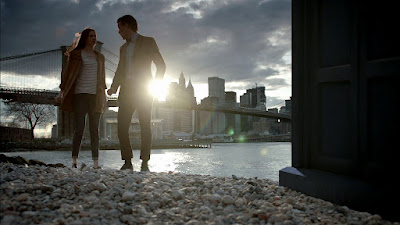The title probably derives from the Rogers & Hart song Manhattan, written in 1925. The original lyric read "We'll have Manhattan, the Bronx and Staten Island too..." but this was later amended to "I'll take Manhattan..." by some singers, such as Sinatra, and has sort of stuck.
To "take" a city means simply to become a success there - e.g. to become the most popular business. To take Broadway, for instance, meant to become its biggest star or to produce the top box office hit.
In 1987 Leonard Cohen released the song First We Take Manhattan, and the same year saw a soapy mini-series called I'll Take Manhattan.
The 1980's saw movies The Muppets Take Manhattan, and Friday 13th VIII: Jason Takes Manhattan, so it was definitely a relatively well known phrase by then.
Also, in 2011, Karen Gillan had starred as model Jean Shrimpton in the BBC4 biographical drama We'll Take Manhattan.
The episode was originally going to be the last of four new stories which would comprise the first half of Series 7, and see out Amy and Rory as companions.
Gillan was the first to inform Moffat that she wished to leave, but it transpired that Arthur Darvill was thinking along the same lines. They met with Moffat and planned when best to organise their final story. They both wished to leave in a manner which would preclude them coming back again later - so a clean break. neither wanted to come back, even in a cameo appearance (though Gillan did eventually record one scene for Matt Smith's final story). The writer had a year to plan their departure.
Inextricably linked to the Ponds, the story would definitely involve River Song.
Moffat later claimed that he rewrote the ending 20 times, unsure whether or not to actually kill the couple off.
One of his starting points was J M Barrie's Peter Pan - in that whilst Peter remained youthful, the people he knew would grew up. This had been addressed before by RTD in episodes such as School Reunion, when the Doctor had to explain what stopped him having a relationship with a human being.
The New York setting was inspired by a holiday there, during which Moffat and his family became snowbound. He and the regulars had enjoyed the city on promotional visits, and Darvill would later enjoy a successful Broadway stint.
The city was very much geared up to support filming for TV and cinema, and the production team were helped out by the US line producer who had assisted with the Utah shoot for Series 6.
Keen to use the Weeping Angels again in a big story, Moffat saw photographs of the Bethesda Fountain in Central park, which included cherubs - baby angels.
The fountain would feature in the episode itself, instrumental in Rory's temporal abduction to 1938.
(It also plays an iconic role in the 2003 HBO adaptation of Angels in America, based on the play by Tony Kushner).
The 1930's setting for the bulk of the story came from a love of film noir, with River's alter ego, Melody Malone, inspired by the "hard-boiled" private detective genre.
Grayle was named after a character in Raymond Chandler's Farewell My Lovely (1940). He was inspired by Sydney Greenstreet - the "Fat Man" in The Maltese Falcon (1941).
Sam Garner's name hints at Dashiell Hammett's Sam Spade (played by Bogart in the above film), and actor James Garner (famed for portraying down-at-heel PI Jim Rockford).
Battery Park was an obvious choice for the location of the apartment block Winter Quay - as the building was being used by the Angels as a battery / storage unit for the potential energy of its captives.
In his script, Moffat stated that the gothic building should be like something out of Charles Addams (creator of The Addams Family), crossed with something from a David Lynch movie.
Despite being made of metal rather than stone, the Statue of Liberty is the most famous statue in the city - so it was inevitable that it would become a Weeping Angel.
It doesn't actually do anything, and the idea that it can cross the city seemingly unnoticed is daft, so its inclusion was purely to provide some iconic imagery for the episode.
The ancient Chinese sequence is set in the year 221 BC - a Sherlock Holmes in-joke. And the first chapter of the Melody Malone novel is "The Dying Detective" - another Holmes reference.
Next time: Let it snow, let it snow, let it snow...

No comments:
Post a Comment